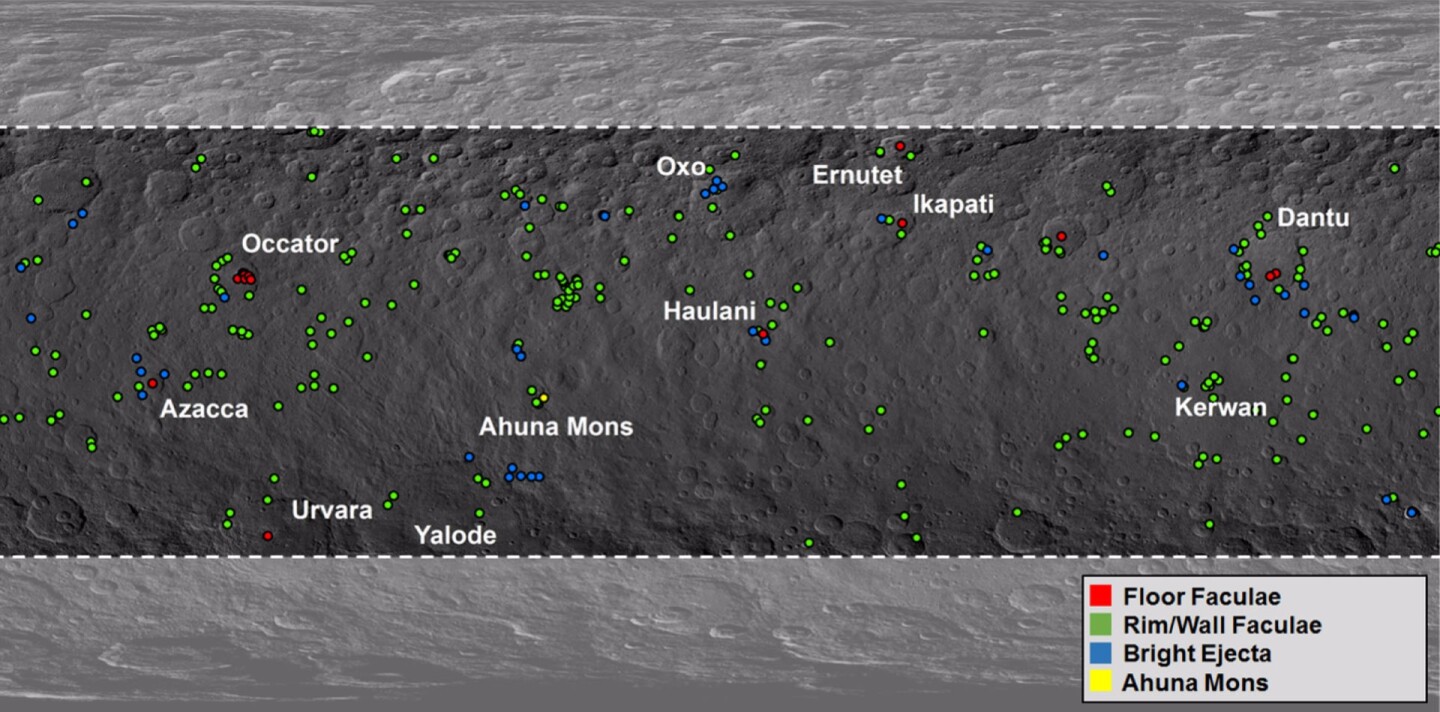Fresh research has been published detailing the processes responsible for the creation of the enigmatic features marking the surface of the dwarf planet Ceres, including the bright spots at the famous Occator Crater, and the so-called "lonely mountain."
Following Dawn's approach to Ceres in early 2015, the dwarf planet became the subject of debate among space enthusiasts and experts alike, thanks to the presence of an unexplained white patch that shined in stark contrast to the dark, unreflective surface of the alien world.
As Dawn drew nearer to the little planet, scientists and conspiracy theorists grappled with the nature of the apparition. Some imaginative individuals suggested that the spots were alien cities, even going so far as to say that they had spotted buildings and UFOs in NASA imagery beamed back by Dawn. Other, cooler heads, hypothesized that the bright points represented cryovolcanic activity, or reflective salt deposits.
Well, Dawn has spent close to three years orbiting Ceres, and whilst (predictably) no trace has been found of an alien colony, the dwarf planet has been fascinating to behold.

We now know that the bright patches that speckle Ceres are actually deposits of salty material. Granted, this isn't as sexy as aliens, but it's informing scientists' understanding of the solar system, so get on board. After all, the Dawn team had expected to find a dead world, yet it was presented with a fascinating, if bleak dwarf planet, riddled with unusual phenomena that amounts to evidence of recent geological activity.
The recently published international study focuses on just how the 300-plus bright spots that dapple Ceres' otherwise unreflective surface came to be. The authors of the paper broke these processes down into four categories.
The first and second categories detailed in the paper deal with the creation of bright, salt-rich spots in impact sites, such as the 57-mile-wide (92 km) Occator Crater, where Dawn first spotted the bright deposits on its approach to Ceres. These are the brightest kind of spots to be found marking the dwarf planet.
Occator plays host to two distinct bright deposits – the first is located in the centre of the crater, in an area known as Cerealia Facula. This region is covered with a 6-mile-wide (10 km) patch of bright material, and features a small dome-like structure in the middle. To the East, but still inside the crater, is another accumulation of bright material. This scattered deposit is referred to as Vinalia Faculae.

The team believe that the Occator Crater once hosted a significant reservoir of salty water hidden beneath the surface. Cerealia Facula could have formed when this liquid flowed upward like icy lava through fractures created by the colossal impact that forged the Crater. Upon reaching the surface, the liquid swelled to form the distinctive dome-like feature, and intermittent eruptions of material from the dome sprayed the surrounding area with ice and salt particles, creating the wider reflective surface.
The nearby Vinalia Faculae deposits may have formed via a slightly different process. According to the researchers, the briny reservoir of water beneath Occator could have been forced to the surface by the release of a volatile gas, such as carbon dioxide or methane. As the liquid passed through the cracks and drew near to the surface, the low-pressure environment would have caused it to boil and, as vapor, spread ice and salt particles across the surface.
The second way that bright, salty material could have reached the surface is once again linked to the destructive effects of an asteroid strike. These events expose deposits at the rim and in the interior of a crater, in streaks that lead down to the centre.
Thirdly, bright salty material can be excavated and thrown over a wide area surrounding a crater by the sheer cataclysmic force of an asteroid strike.

Finally, we come to the "lonely mountain" - Ahuna Mons. On present-day Ceres, raised features such as the lonely mountain are rare, though earlier research suggests that the dwarf planet's surface was once much more mountainous, and that the peaks only subsided over the last few billion years.
Ahuna Mons exhibits bright streaks down its sides, but the presence of the material is, for once, not the result of an asteroid strike. Instead, the team believes that the mountain itself is a cryovolcano, whose volcanic dome formed when an accumulation of bright, dense and slow flowing icy materials froze upon reaching Ceres' surface.
On October 19th, NASA announced that it had authorized a second extension to Dawn's mission around Ceres. This final phase will take the probe within 120 miles (200 km) of the dwarf planet's surface, and will allow the spacecraft to remain in orbit as Ceres makes its closest approach to the Sun in April 2018.
The paper has been published in the journal Icarus.
Source: NASA









